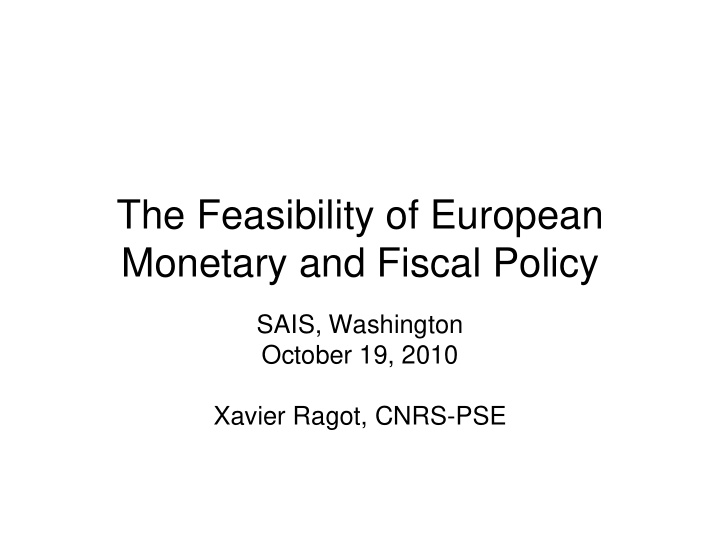



The Feasibility of European Monetary and Fiscal Policy SAIS, Washington October 19, 2010 Xavier Ragot, CNRS-PSE
I – The Problems We Face 1) Low Private Demand a) Uncertainty about future taxes (Ricardian Equivalence). Alesina vs IMF b) Reduction in permanent income. Correction of a wealth effect ) after the housing bubble. Deleveraging. c) Precautionary savings (Paradox of thrift) 2) Uncertainty about the output gap What is potential output after the crisis? f ? What type of capital has been destroyed by the crisis? Human capital destruction skill mis match break in the Beveridge Human capital destruction, skill mis-match, break in the Beveridge curve
3) High public debt Difficult to identify the problem of a high public debt. Some studies find th thresholds of 70% or 90% is very detrimental to growth. Correlation h ld f 70% 90% i d t i t l t th C l ti causality? Italy, high public debt since 2000, is it the main problem of Italy? The same for Japan and Greece… I think that there is still lots of room for manoeuvre in lots of countries I thi k th t th i till l t f f i l t f t i The question of fiscal consolidation should be high on the agenda. But it seems difficult to justify a very short horizon for fiscal consolidation based on the argument of default risk. t f d f lt i k 4) Zero lower bond A real problem, other tools such as Quantitative Easing, but what is the goal : - The fight against deflation, - liquidity provision to the banking sector for financial stability - Increase in credit and spending. Transmissions mechanisms are difficult to assess in periods of financial Transmissions mechanisms are difficult to assess in periods of financial fragility. (VLTRO)
II - Specific European Problems: H Heterogeneity i G Germany is one of the strongest economies of the world, and Greece i f h i f h ld d G one of the weakest, in the same monetary area a) Countries with strong banking systems (France) countries with a) Countries with strong banking systems (France), countries with fragmented and fragile banking system (Germany and others...) b) Germany: exporters of high quality goods (little effects of exchange rate on exports). France: higher impact of exchange rates on t t ) F hi h i t f h t exports + different industrial structure. c) Those countries have relatively low public debt Greece and Italy: c) Those countries have relatively low public debt. Greece and Italy: high public debt.
Political Economy: Moral hazard Political Economy: Moral hazard 1) P 1) Persistent banks in the euro area. i t t b k i th Segmented banking system: strong and solid banks and some persistent banks which rely on cheap money from the ECB. Hidden financial fragility, fiscal transfers necessary to clean the g y, y banking system. Not popular: reliance on monetary policy 2) S 2) Second fiscal policy d fi l li Heterogeneity in GDP/effect of shocks: Fiscal transfers across regions: Will it be the same forever, with asymmetric shocks in the same direction? Political debate: Fiscal crisis management is different from structural transfers. European Fund of Financial Stability: raise up to 440 billion euros on the market with German and French support billion euros on the market with German and French support.
Fiscal tools are more efficient in times of Fiscal tools are more efficient in times of crises: Fiscal multiplier is large and consolidation is costly consolidation is costly. Delayed fiscal consolidation is necessary. Crisis has exacerbated political economy issues in Europe.
Recommend
More recommend